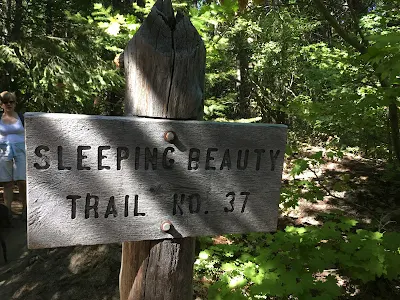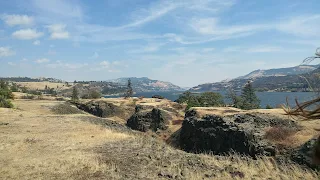“In the beginning was the foot.”
-Marvin Harris
Some of my greatest memories are uphill.
“Let’s go for a walk,” my dad would say. With the sky turning golden in the late summer sun we would hike up the trails to the top the hill, dad smoking his pipe tobacco as the sound of the diving nighthawks low-whistled in the crisping air.
In the hills of the Columbia River Gorge all trails went uphill eventually. Where I lived the scrub oak would thin out toward the top as the trails doubled back and grew steeper. At last the view would open to reveal white-topped mountains and vistas worthy of postcards.
Climbing a trail through a forest, hiking to that payoff at the top is a pleasure I’m continually rediscovering.
My hiking days started with my dad when I was young. Wherever he lives, he always knows the local trails. We were never formal hikers, with special boots and backpacks and planned excursions. It was always, “let’s take this trail and see where it goes.”
Walking is older than man.
“In the beginning was the foot,” famed anthropologist Marvin Harris wrote. “Four million years ago, before speech or consciousness, our ancestors already walked erect on two feet.”
We walked with our hands free to hunt and gather. We walked to follow game and lost the hair from our bodies in the African sun. As we walked, our brains grew bigger. As we walked, we spread across the planet to almost every corner -- on foot. Long before the common modes of horse or cart or car or train, we walked.
We walked to the top of mountains - in the Andes, the Alps and the Himalayas -- and built cities in the clouds.
Anything which ceases to be necessary, soon becomes either art or recreation.
Such was the case with hiking.
In rural areas, walking a trail through the woods is still often a necessity - for hunting or fishing, for work in the forest. Walking a trail for the sake of the experience is different, a byproduct of the increasingly urban landscape that developed with the Industrial Revolution. In Europe the Pilgrimage trails and market footpaths that lead from village to village became embraced by pioneers like Phillip Bussemer who promoted and published some of the first hiking guides through Germany’s Black Forest at the end of the 19th century.
In some ways, hiking is a true “swords into ploughshares activity.” It this country, it was the surplus of sturdy shoes and camping equipment after the Civil War that first lead to a discovery of the outdoor pleasures of hiking in the wilderness to an increasingly urban and affluent America.
The creation of the National Park system and the construction of trails by recreation clubs and later the Civilian Conservation Corps ensured that these vistas were preserved and trails were maintained.
Interest in hiking has increased after each subsequent major conflict with a boom particularly after World War II. Special equipment replaced the surplus gear, guidebooks mapped out trails and advised trekkers. Generations of scouts discovered the joys of walking in nature. Some have argued that the more divorced and urban the lifestyle, the more novel and enriching the experience.
The creation of the National Park system and the construction of trails by recreation clubs and later the Civilian Conservation Corps ensured that these vistas were preserved and trails were maintained.
Interest in hiking has increased after each subsequent major conflict with a boom particularly after World War II. Special equipment replaced the surplus gear, guidebooks mapped out trails and advised trekkers. Generations of scouts discovered the joys of walking in nature. Some have argued that the more divorced and urban the lifestyle, the more novel and enriching the experience.
These days ,of course, have progressed beyond written hiking guides to internet sites with detailed photos and videos of the hike. Now you know what you are getting into even before you leave the warm comfort of your home.
Yet there are still surprises, still vistas worth ascending to discover. Vistas to which no photo can do justice, because the hike itself is somehow integral to experience.
Walking -- if not hiking -- has always been a part of my life -- even back when I didn’t venture out to explore all these wonderful trails. I have spent many a day walking the fields with dogs. Even in my sedentary desk-job days, when I would spend 60 hours a week on the internet, I made time most days to walk the riverbank near my home rain or shine to clear my head before writing. This last decade my work has been more active - nursing is hours of walking. Amy and I have taken up running, which has improved our stamina and opened our horizons to what we are capable of achieving. True northwesterners, the weather doesn’t discourage us, but we stick to lower elevations when the trails get slick and muddy.
Hell is to walk with me.
As my wife and daughters can attest, my short legs still somehow stride long and quickly, trudging aggressively when there is a hill to climb. I like hiking, I like climbing a trail that curves through a forest, or under a waterfall. My favorite hikes are those that climb above tree lines at their climax, rewarding tired legs with an endless view.
Whenever we go on vacation, we find ourselves hiking.
Whether it is a Bray Cliff Walk on the coast of Ireland, or the Wasserfallstieg in the Black Forest of Germany to the Stone Mountain trail of North Carolina, it seems we always find a hike whenever we travel.
Yet Amy and I find we don’t need to travel far to find great hikes. Some of the most amazing trails are right in our backyard. Washington and Oregon parks are filled with paved paths through the dunes and along the coast for those days when we’d rather hike on flat trails with the music of ocean waves crashing in our ears. The paved trails at Ft Stevens are wonderful and take you through all sorts of habitats.
As our legs have grown stronger, we have recently become more ambitious, climbing to the top of Sleeping Beauty on Mt Adams - where you are so high you can see the wheat fields of Oregon from it’s rocky top. Just a year ago, we were at Coldwater Lake on Mt St Helens exploring the fall colors under a bluebird sky. We were unable to hike the whole loop - so that gives us an excuse to go back.
This past Spring, Amy and I finally conquered a wildflower-crowned Saddle Mountain - the clouds clearing as we ate a lunch of apples at the top of the world.
We have only begun to hike.
We have a running list of trails that we want to explore and God willing, years to explore.
Four decades later, my dad is still hiking miles at a time, still climbing mountains when he can. Sitting in a car is harder on him than putting a half-dozen miles under his 80 year old feet. More often he takes the dogs for a hike on the trails behind his house.
There is always a bit of magic on a trail through the forest whether it is behind your house of halfway around the world.
It is always a good day for a hike.
-30-































